Investigation of Tribological Characteristics of PEO Coatings Formed on Ti6Al4V Titanium Alloy in Electrolytes with Graphene Oxide Additives
Abstract
1. Introduction
2. Materials and Methods
3. Results and Discussion
4. Conclusions
Author Contributions
Funding
Institutional Review Board Statement
Informed Consent Statement
Data Availability Statement
Acknowledgments
Conflicts of Interest
Appendix A
References
- Smurov, I.; Doubenskaia, M.; Grigoriev, S.; Nazarov, A. Optical Monitoring in Laser Cladding of Ti6Al4V. J. Therm. Spray Technol. 2012, 21, 1357–1362. [Google Scholar] [CrossRef]
- Lei, Z.; Gao, P.; Wang, X.; Zhan, M.; Li, H. Analysis of anisotropy mechanism in the mechanical property of titanium alloy tube formed through hot flow forming. J. Mater. Sci. Technol. 2021, 86, 77–90. [Google Scholar] [CrossRef]
- Sieniawski, J.; Filip, R.; Ziaja, W. The effect of microstructure on the mechanical properties of two-phase titanium alloys. J. Mater. Process. Technol. 2003, 133, 84–89. [Google Scholar] [CrossRef]
- Kaur, M.; Singh, K. Review on titanium and titanium based alloys as biomaterials for orthopaedic applications. Mater. Sci. Eng. C 2019, 102, 844–862. [Google Scholar] [CrossRef]
- Li, J.; Wang, Y.; Yao, Y.; Wang, Y.; Wang, L. Structure and tribological properties of TiSiCN coating on Ti6Al4V by arc ion plating. Thin Solid Films 2017, 644, 115–119. [Google Scholar] [CrossRef]
- Li, Y.; Zhou, Q.; Liu, M. Effect of novel surface treatment on corrosion behavior and mechanical properties of a titanium alloy. Baosteel Techol. Res. 2021, 15, 11–19. [Google Scholar]
- Volosova, M.A.; Grigoriev, S.N.; Kuzin, V.V. Effect of Titanium Nitride Coating on Stress Structural Inhomogeneity in Oxide-Carbide Ceramic. Part 4. Action of Heat Flow. Refract. Ind. Ceram. 2015, 56, 91–96. [Google Scholar] [CrossRef]
- Novoselov, K.S.; Geim, A.K.; Morozov, S.V.; Jiang, D.; Zhang, Y.; Dubonos, S.V.; Grigoriev, I.V.; Firsov, A.A. Electric field effect in atomically thin carbon films. Science 2004, 306, 666–669. [Google Scholar] [CrossRef][Green Version]
- Song, Y.; Liu, W.; Sun, Y.; Guan, S.; Chen, Y. Microstructural Evolution and Mechanical Properties of Graphene Oxide-Reinforced Ti6Al4V Matrix Composite Fabricated Using Spark Plasma Sintering. Nanomaterials 2021, 11, 1440. [Google Scholar] [CrossRef]
- Yanjie, Y.; Mabao, L.; Shiqi, Z.; Weijia, R.; Qihang, Z.; Lan, S. Breaking through the strength-ductility trade-off in graphene reinforced Ti6Al4V composites. J. Alloys Compd. 2021, 871, 159535. [Google Scholar]
- Dong, M.; Zhou, W.; Zhou, Z.; Naoyuki, N. Simultaneous enhancement of powder properties, additive manufacturability, and mechanical performance of Ti–6Al–4V alloy by 2D-nanocarbon decoration. Mater. Sci. Eng. A 2022, 859, 144215. [Google Scholar] [CrossRef]
- Gong, Y.; Wu, M.; Miao, X.; Cui, C. Effect of laser power on corrosion behavior of GO/Ti-6Al-4V coating in simulated body fluid solution. J. Laser Appl. 2022, 34, 022004. [Google Scholar] [CrossRef]
- Taheridoustabad, I.; Khosravi, M.; Yaghoubinezhad, Y. Fabrication of GO/RGO/TiC/TiB2 nanocomposite on Ti-6Al-4V alloy using electrical discharge coating and exploring its tribological properties. Tribol. Int. 2021, 156, 106860. [Google Scholar] [CrossRef]
- Nasiłowska, B.; Skrzeczanowski, W.; Bombalska, A.; Bogdanowicz, Z. Laser Emission Spectroscopy of Graphene Oxide Deposited on 316 Steel and Ti6Al4V Titanium Alloy Suitable for Orthopedics. Materials 2023, 16, 2574. [Google Scholar] [CrossRef]
- Aslan, N.; Aksakal, B.; Dikici, B.; Sinirlioglu, Z.A. Graphene reinforced hybrid-bioceramic coatings on porous-Ti6Al4V for biomedical applications: Morphology, corrosion resistance, and cell viability. J. Mater. Sci. 2022, 57, 16858–16874. [Google Scholar]
- Wang, X.; Diwu, W.; Guo, J.; Yan, M.; Ma, W.; Yang, M.; Bi, L.; Han, Y. Enhancement of antibacterial properties and biocompatibility of Ti6Al4V by graphene oxide/strontium nanocomposite electrodepositing. Biochem. Biophys. Res. Commun. 2023, 665, 35–44. [Google Scholar] [CrossRef]
- Wen, Q.; Jing, M.; Qian, L.; Jingdan, L.; Bin, T. Tribological, cytotoxicity and antibacterial properties of graphene oxide/carbon fibers/polyetheretherketone composite coatings on Ti–6Al–4V alloy as orthopedic/dental implants. J. Mech. Behav. Biomed. Mater. 2021, 122, 104659. [Google Scholar]
- Zhou, Y.; Mengxin, D.; Jun, H.; Hui, Y. Preparation of graphene oxide coatings on textured Ti6Al4V by laser micromachining and electrophoretic deposition for improved biocompatibility. Opt. Laser Technol. 2022, 154, 108342. [Google Scholar]
- Grigoriev, S.; Pristinskiy, Y.; Volosova, M.; Fedorov, S.; Okunkova, A.; Peretyagin, P.; Smirnov, A. Wire Electrical Discharge Machining, Mechanical and Tribological Performance of TiN Reinforced Multiscale SiAlON Ceramic Composites Fabricated by Spark Plasma Sintering. Appl. Sci. 2021, 11, 657. [Google Scholar] [CrossRef]
- Apelfeld, A.V.; Belkin, P.N.; Borisov, A.M.; Vasin, V.A.; Krit, B.L.; Ludin, V.B.; Somov, O.V.; Sorokin, V.A.; Suminov, I.V.; Frantskevich, V.P. Modern Technologies for Modification of Materials Surface and Formation of Protective Coatings. In Micro-Arc Oxidation; Renome: Moscow-St.-Petersburg, Russia, 2017; Volume 1, 648p, ISBN 978-5-91918-832-2. [Google Scholar]
- Grigoriev, S.; Peretyagin, N.; Apelfeld, A.; Smirnov, A.; Yanushevich, O.; Krikheli, N.; Kramar, O.; Kramar, S.; Peretyagin, P. Investigation of MAO Coatings Characteristics on Titanium Products Obtained by EBM Method Using Additive Manufacturing. Materials 2022, 15, 4535. [Google Scholar] [CrossRef]
- Diaz, L.A.; Montes-Moran, M.A.; Peretyagin, P.Y.; Vladimirov, Y.G.; Okunkova, A.; Moya, J.S.; Torrecillas, R. Zirconia-alumina-nanodiamond composites with gemological properties. J. Nanopart. Res. 2014, 16, 2257. [Google Scholar] [CrossRef]
- Podrabinnik, P.; Gershman, I.; Mironov, A.; Kuznetsova, E.; Peretyagin, P. Mechanisms involed in the formation of secondary structures on the friction surface of experimental aluminium alloys for monometallic journal bearings. Lubricants 2018, 6, 104. [Google Scholar] [CrossRef][Green Version]
- Borisov, A.M.; Krit, B.L.; Lyudin, V.B.; Morozova, N.V.; Suminov, I.V.; Apelfeld, A.V. Microarc oxidation in slurry electrolytes: A review. Surf. Eng. Appl. Electrochem. 2016, 52, 50–78. [Google Scholar] [CrossRef]
- Smirnov, A.; Seleznev, A.; Solis Pinargote, N.W.; Pristinskiy, Y.; Peretyagin, P.; Bartolome, J.F. The Influence of Wire Electrical Discharge Machining Cutting Parameters on the Surface Roughness and Flexural Strength of ZrO2/TiN Ceramic Nanocomposites Obtained by Spark Plasma Sintering. Nanomaterials 2019, 9, 1391. [Google Scholar] [CrossRef] [PubMed][Green Version]
- Xue, H.; Zhu, M.; Dong, L.L.; Zhang, W.; Sun, X.C.; Wang, Y.M.; Fu, Y.Q.; Zhang, Y.S. In-situ synthesis of reduced graphene oxide/aluminium oxide nanopowders for reinforcing Ti-6Al-4V composites. J. Alloys Compd. 2022, 905, 164198. [Google Scholar] [CrossRef]
- Shokouhfar, M.; Allahkaram, S. Effect of incorporation of nanoparticles with different composition on wear and corrosion behavior of ceramic coatings developed on pure titanium by micro arc oxidation. Surf. Coat. Technol. 2017, 309, 767–778. [Google Scholar] [CrossRef]
- Wang, Y.M.; Jiang, B.L.; Lei, T.Q.; Guo, L.X. Microarc oxidation and spraying graphite duplex coating formed on titanium alloy for antifriction purpose. Appl. Surf. Sci. 2005, 246, 214–221. [Google Scholar] [CrossRef]
- Wang, Y.M.; Jiang, B.L.; Lei, T.Q.; Guo, L.X. Tribological behavior of microarc oxidation coatings formed on titanium alloys against steel in dry and solid lubrication sliding. Appl. Surf. Sci. 2006, 252, 2989–2998. [Google Scholar] [CrossRef]
- Guo, Y.; Xu, L.; Luan, J.; Wan, Y.; Li, R. Effect of carbon nanotubes additive on tribocorrosion performance of micro-arc oxidized coatings on Ti6Al4V alloy. Surf. Interfaces 2022, 28, 101626. [Google Scholar] [CrossRef]
- Chen, X.; Liao, D.; Zhang, D.; Jiang, I.; Zhao, P.; Xu, R. Friction and wear behavior of graphene-modified titanium alloy micro-arc oxidation coatings. Trans. Indian Inst. Met. 2020, 73, 73–80. [Google Scholar] [CrossRef]
- Mazinani, A.; Nine, J.; Chiesa, R.; Candiani, G.; Tarsini, P.; Tung, T.T.; Losic, D. Graphene oxide (GO) decorated on multi-structured porous titania fabricated by plasma electrolytic oxidation (PEO) for enhanced antibacterial performance. Mater. Des. 2021, 200, 109443. [Google Scholar] [CrossRef]
- Zhang, R.; Lv, K.; Du, Z.; Chen, W.; Ji, P.; Wang, M. Effects of graphene on the wear and corrosion resistance of micro-arc oxidation coating on a titanium alloy. Metals 2022, 12, 70. [Google Scholar] [CrossRef]
- Hummers, W.S., Jr.; Offeman, R.E. Preparation of graphitic oxide. J. Am. Chem. Soc. 1958, 80, 1339. [Google Scholar] [CrossRef]
- Smirnov, A.; Peretyagin, P.; Bartolomé, J.F. Processing and mechanical properties of new hierarchical metal-graphene flakes reinforced ceramic matrix composites. J. Eur. Ceram. Soc. 2019, 39, 3491–3497. [Google Scholar] [CrossRef]
- Available online: https://lkalloy.com/titanium-alloys/ti6al4v-grade-5/ (accessed on 10 April 2023).
- ASTM G99-17; Standard Test Method for Wear Testing with a Pin-on-Disk Apparatus. American Society for Testing and Materials: West Conshohocken, PA, USA, 2017.
- Zuo, Y.; Li, T.; Yu, P.; Zhao, Z.; Chen, X.; Zhang, Y.; Chen, F. Effect of graphene oxide additive on tribocorrosion behavior of MAO coatings prepared on Ti6Al4V alloy. Appl. Surf. Sci. 2019, 480, 26–34. [Google Scholar] [CrossRef]
- Grigoriev, S.; Peretyagin, N.; Apelfeld, A.; Smirnov, A.; Rybkina, A.; Kameneva, E.; Zheltukhin, A.; Gerasimov, M.; Volosova, M.; Yanushevich, O.; et al. Investigation of the Characteristics of MAO Coatings Formed on Ti6Al4V Titanium Alloy in Electrolytes with Graphene Oxide Additives. J. Compos. Sci. 2023, 7, 142. [Google Scholar] [CrossRef]
- Muntean, R.; Brîndusoiu, M.; Buzdugan, D.; Nemes, N.S.; Kellenberger, A.; Utu, I.D. Characteristics of Hydroxyapatite-Modified Coatings Based on TiO2 Obtained by Plasma Electrolytic Oxidation and Electrophoretic Deposition. Materials 2023, 16, 1410. [Google Scholar] [CrossRef]
- Torskaya, E.V.; Mezrin, A.M.; Mosyagina, I.V.; Kornev, Y.V. Experimental and theoretical study of coating spalling under high cycle frictional loading. Phys. Mesomech. 2018, 21, 475–482. [Google Scholar] [CrossRef]
- Zaitsev, A.N.; Strebkov, Y.S.; Leshukov, A.Y.; Ivanov, V.M.; Kuksenova, L.I.; Sachek, B.Y.; Mezrin, A.M.; Aleksandrova, Y.P. Assessment of critical level of shear stresses in tribocouples of Al2O3 and metal details of ITER blanket modules. J. Mach. Manuf. Reliab. 2016, 45, 522–530. [Google Scholar] [CrossRef]
- Torskaya, E.V.; Goryacheva, I.G. The effect of interface imperfection and external loading on the axisymmetric contact with a coated solid. Wear 2003, 254, 538–545. [Google Scholar] [CrossRef]
- Torskaya, E.V. The analysis of friction effect on the stress-strain condition of coated bodies. J. Frict. Wear 2002, 23, 130–138. [Google Scholar]
- Stepanov, F.I.; Torskaya, E.V. Modeling of indentation of hard coatings by an arbitrarily shaped indenter. J. Frict. Wear 2019, 40, 326–331. [Google Scholar] [CrossRef]
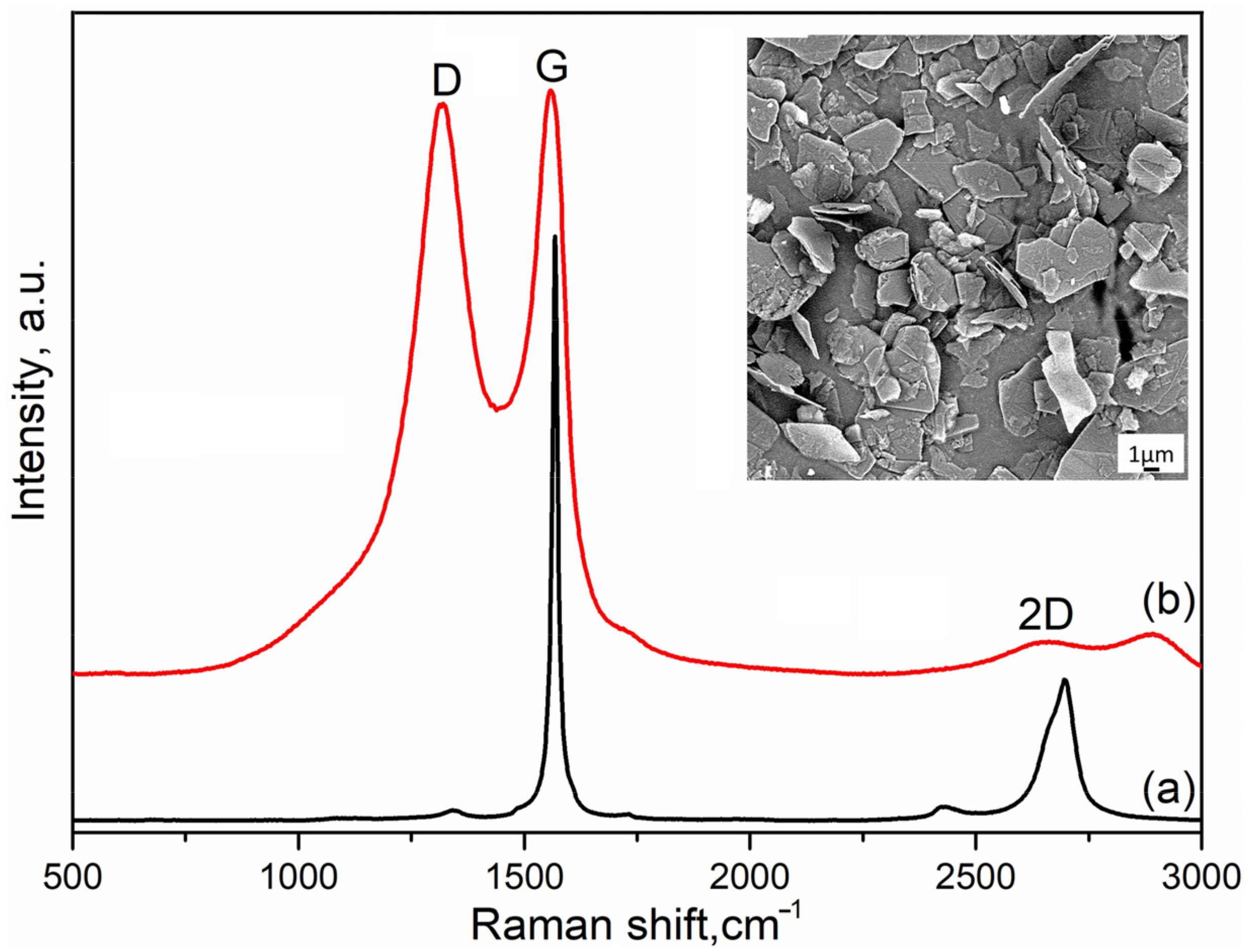
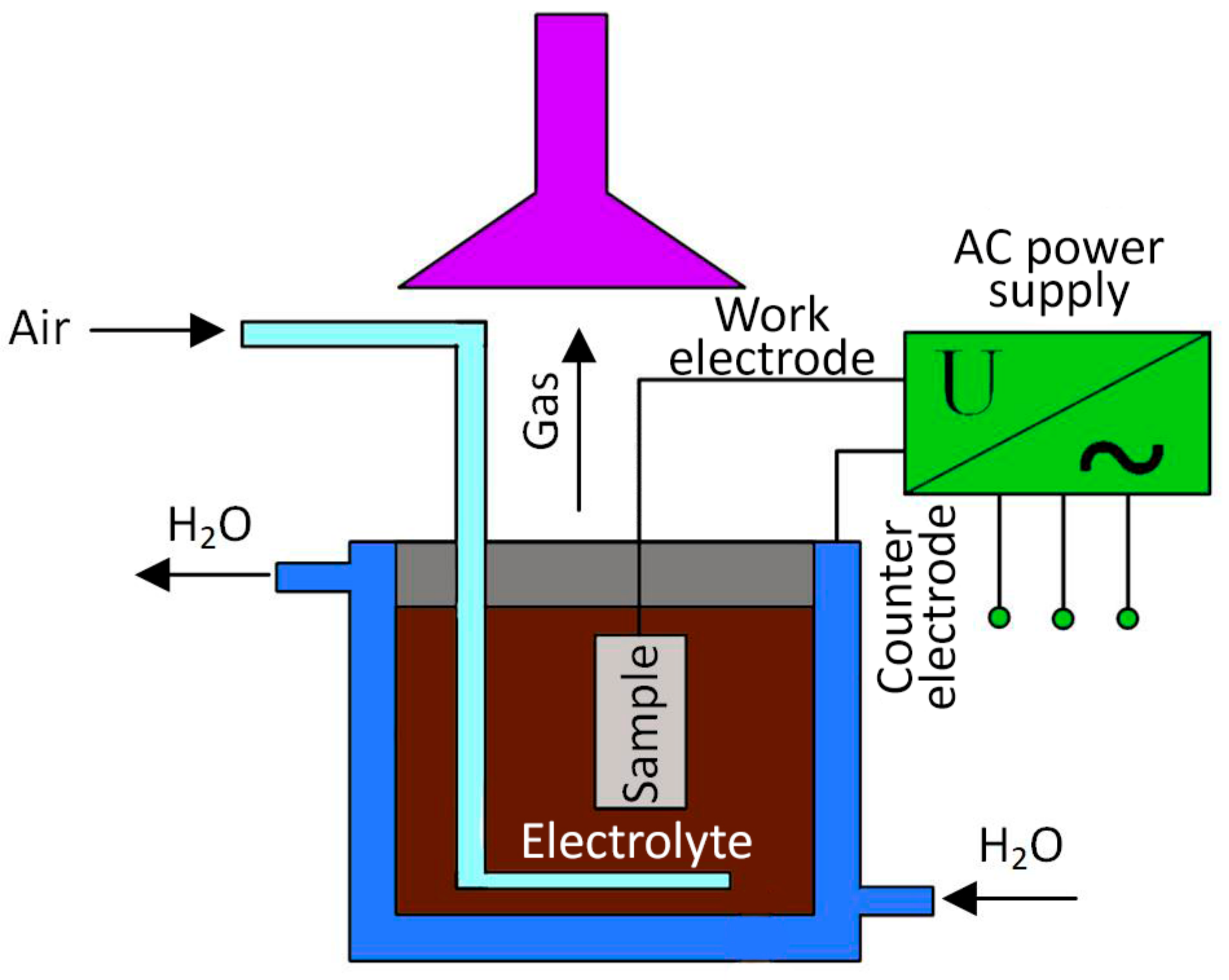

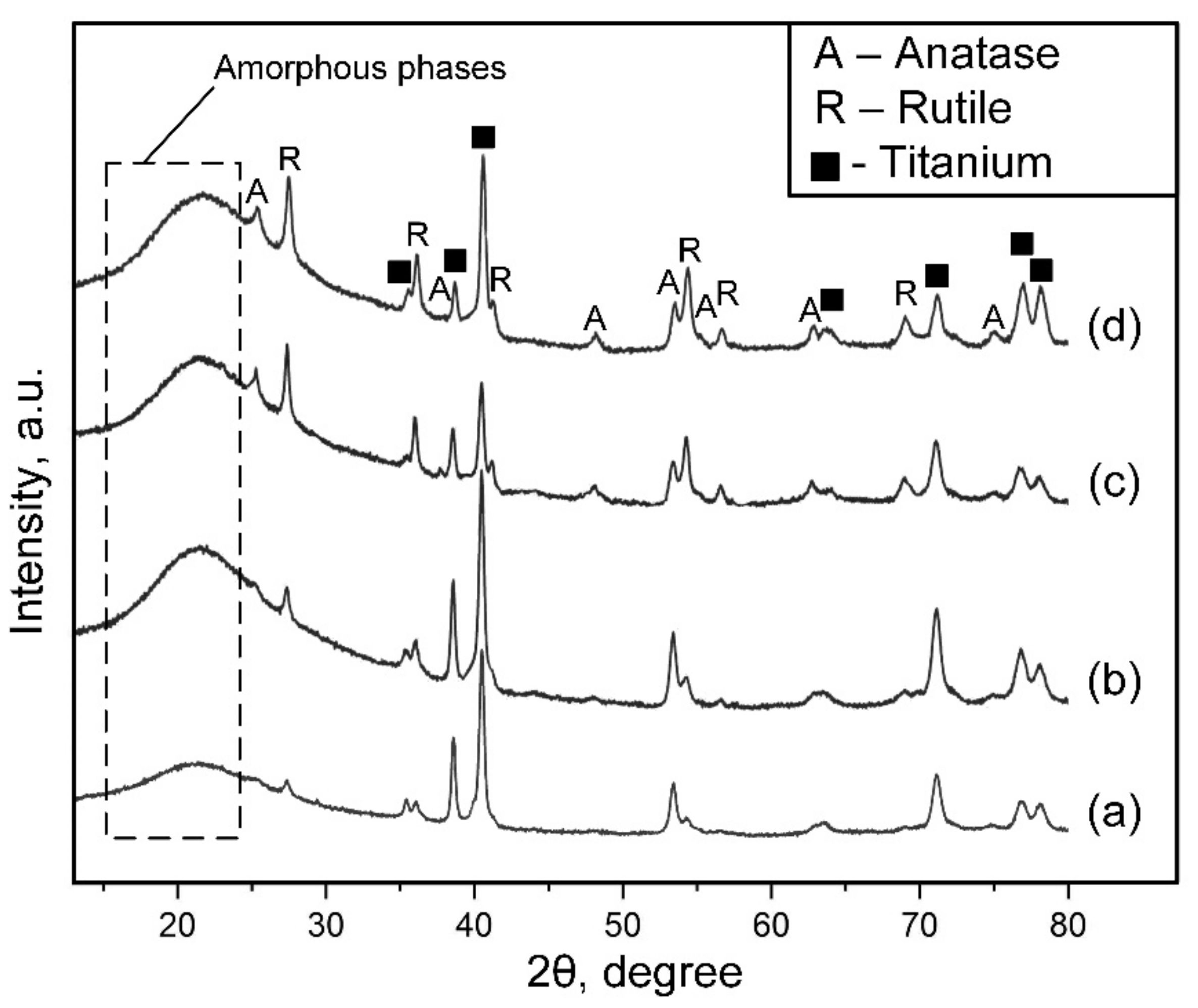
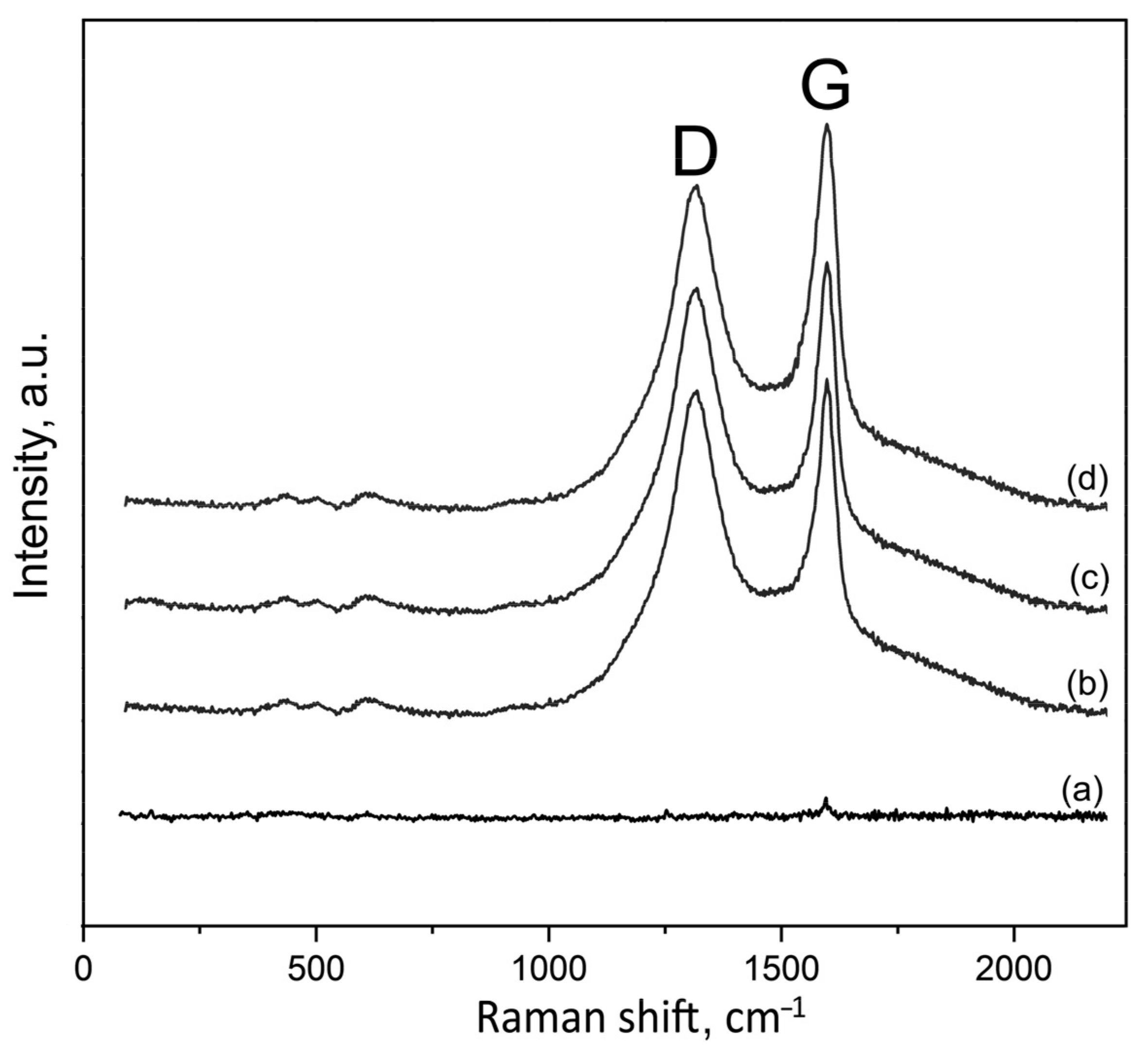
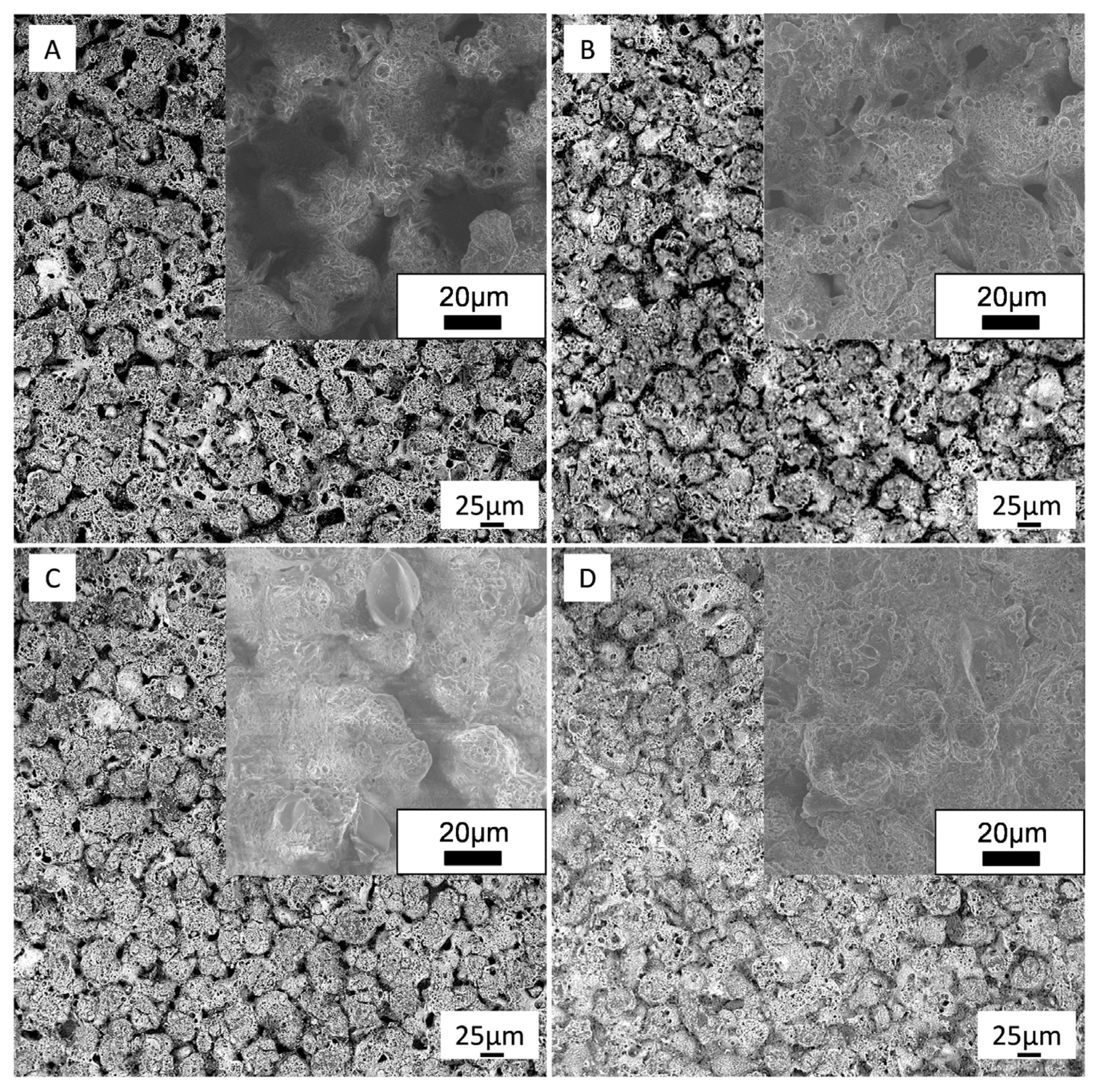


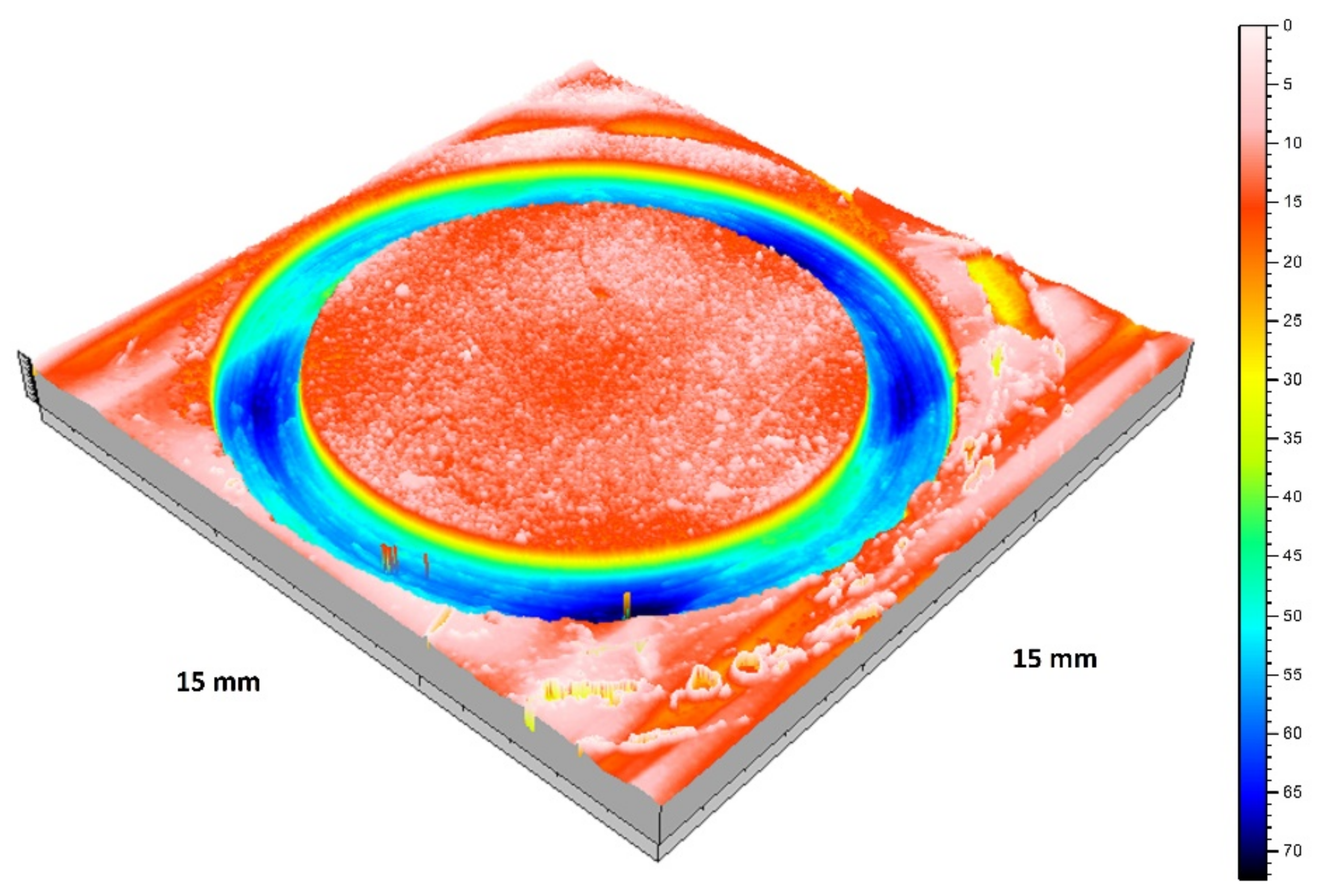
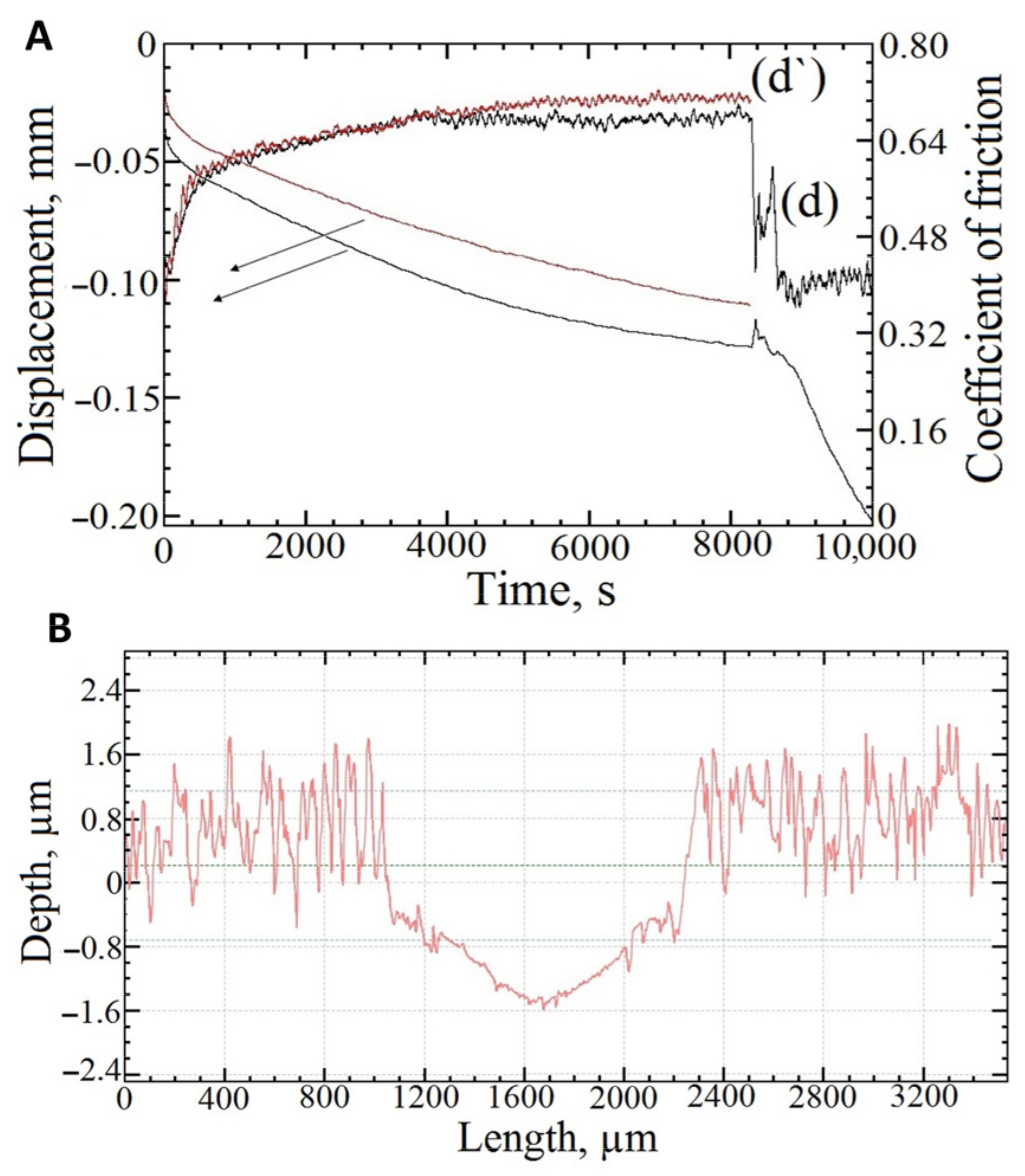
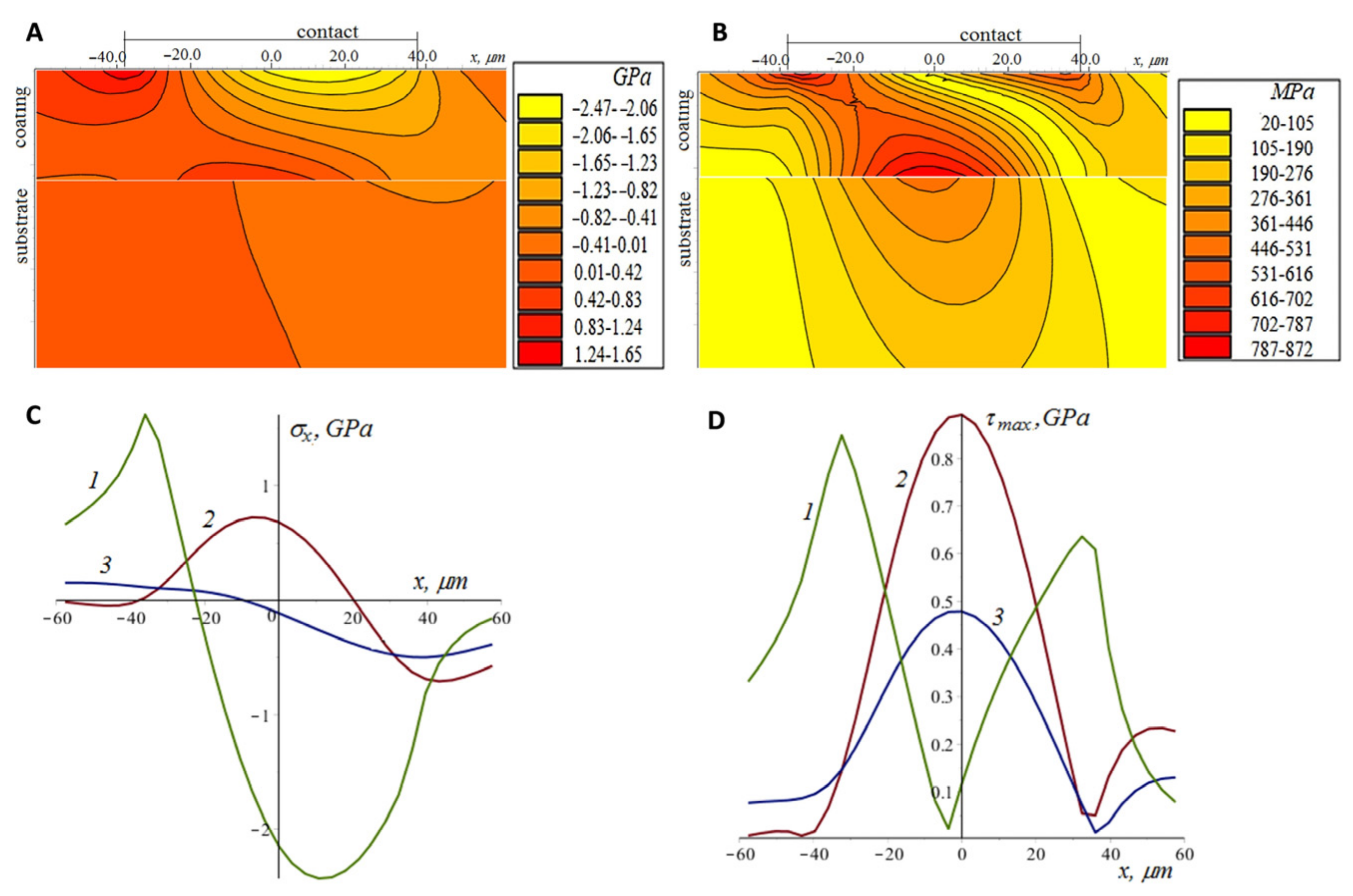

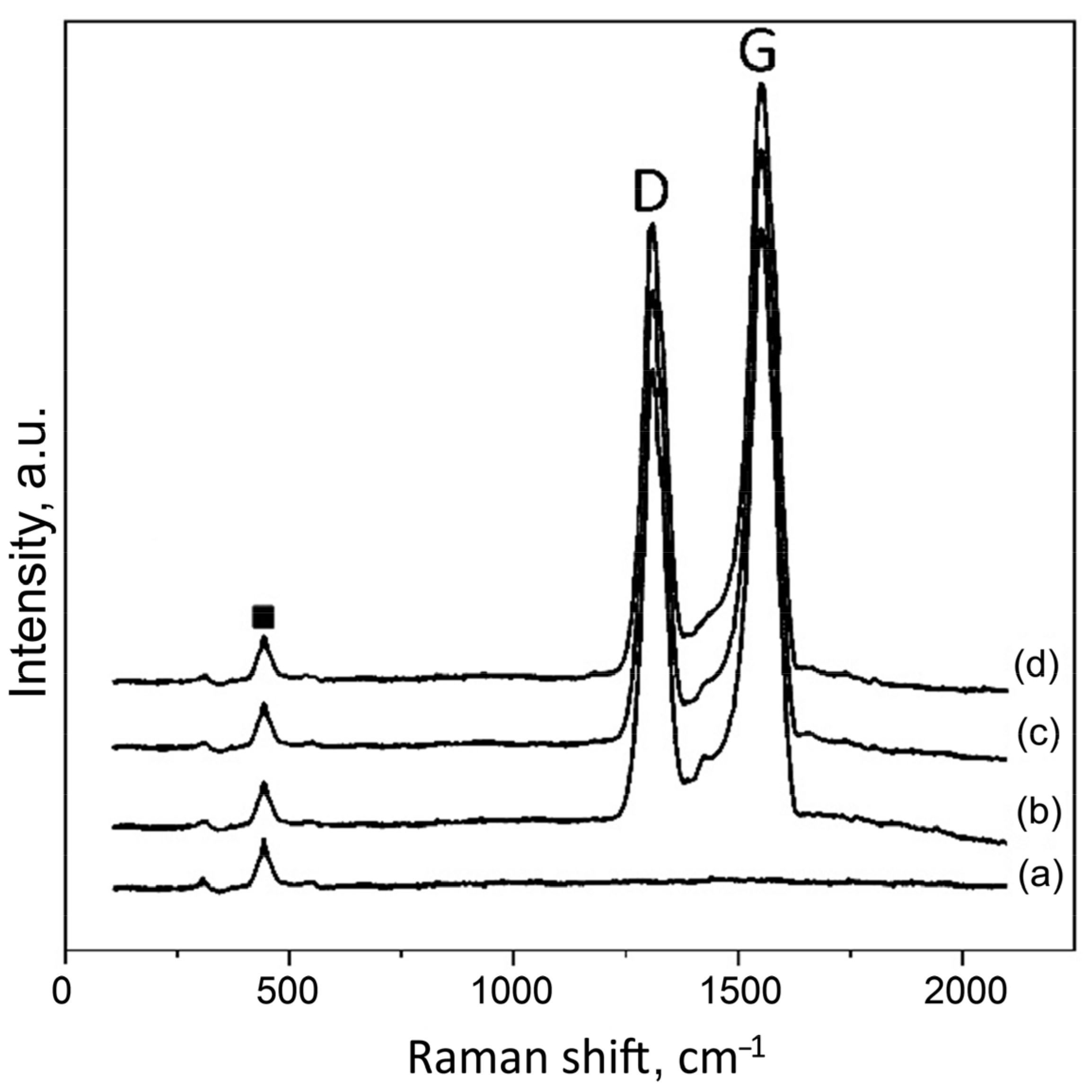

| Structure | Chemical Composition, wt.% | |||||||
|---|---|---|---|---|---|---|---|---|
| α + β | Al | V | C | H | N | Fe | O | Ti |
| 5.5–6.75 | 3.5–4.5 | 0.08 | 0.015 | 0.05 | 0.3 | 0.2 | Bal | |
| Sample Codes | Base Electrolyte | Graphene Oxide Addition, kg/m3 | pH | Conductivity, mS∙cm−1 |
|---|---|---|---|---|
| 0GO | Na2SiO3∙9H2O + Na(PH2O2)∙H2O | 0 | 12.25 | 31.23 |
| 0.1GO | 0.1 | 12.21 | 37.87 | |
| 0.3GO | 0.3 | 12.12 | 41.34 | |
| 0.5GO | 0.5 | 12.04 | 47.61 |
| Samples Code | Coefficient of Friction | Wear Rate, mm3/N·m |
|---|---|---|
| 0GO | 0.73 ± 0.02 | (8.04 ± 0.05)·10−4 |
| 0.1GO | 0.72 ± 0.02 | (6.77 ± 0.04)·10−4 |
| 0.3GO | 0.70 ± 0.01 | (5.86 ± 0.03)·10−4 |
| 0.5GO | 0.69 ± 0.01 | (5.2 ± 0.03)·10−4 |
Disclaimer/Publisher’s Note: The statements, opinions and data contained in all publications are solely those of the individual author(s) and contributor(s) and not of MDPI and/or the editor(s). MDPI and/or the editor(s) disclaim responsibility for any injury to people or property resulting from any ideas, methods, instructions or products referred to in the content. |
© 2023 by the authors. Licensee MDPI, Basel, Switzerland. This article is an open access article distributed under the terms and conditions of the Creative Commons Attribution (CC BY) license (https://creativecommons.org/licenses/by/4.0/).
Share and Cite
Grigoriev, S.; Peretyagin, N.; Apelfeld, A.; Smirnov, A.; Morozov, A.; Torskaya, E.; Volosova, M.; Yanushevich, O.; Yarygin, N.; Krikheli, N.; et al. Investigation of Tribological Characteristics of PEO Coatings Formed on Ti6Al4V Titanium Alloy in Electrolytes with Graphene Oxide Additives. Materials 2023, 16, 3928. https://doi.org/10.3390/ma16113928
Grigoriev S, Peretyagin N, Apelfeld A, Smirnov A, Morozov A, Torskaya E, Volosova M, Yanushevich O, Yarygin N, Krikheli N, et al. Investigation of Tribological Characteristics of PEO Coatings Formed on Ti6Al4V Titanium Alloy in Electrolytes with Graphene Oxide Additives. Materials. 2023; 16(11):3928. https://doi.org/10.3390/ma16113928
Chicago/Turabian StyleGrigoriev, Sergey, Nikita Peretyagin, Andrey Apelfeld, Anton Smirnov, Alexei Morozov, Elena Torskaya, Marina Volosova, Oleg Yanushevich, Nikolay Yarygin, Natella Krikheli, and et al. 2023. "Investigation of Tribological Characteristics of PEO Coatings Formed on Ti6Al4V Titanium Alloy in Electrolytes with Graphene Oxide Additives" Materials 16, no. 11: 3928. https://doi.org/10.3390/ma16113928
APA StyleGrigoriev, S., Peretyagin, N., Apelfeld, A., Smirnov, A., Morozov, A., Torskaya, E., Volosova, M., Yanushevich, O., Yarygin, N., Krikheli, N., & Peretyagin, P. (2023). Investigation of Tribological Characteristics of PEO Coatings Formed on Ti6Al4V Titanium Alloy in Electrolytes with Graphene Oxide Additives. Materials, 16(11), 3928. https://doi.org/10.3390/ma16113928








